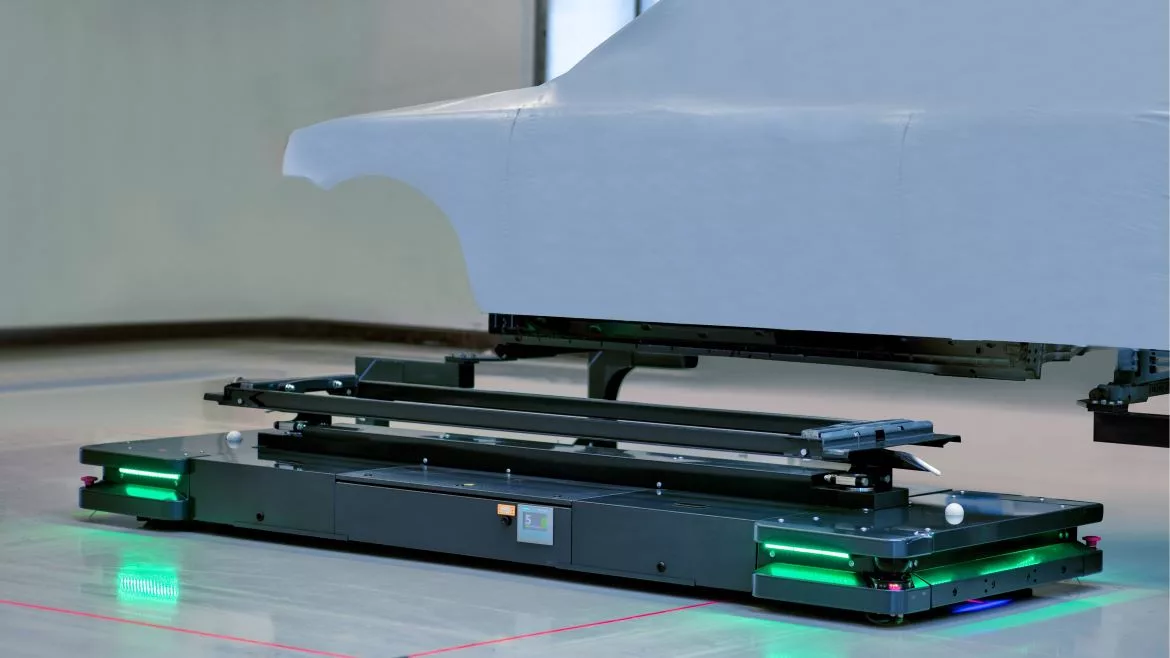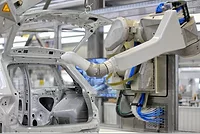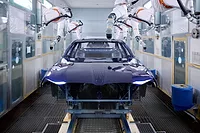Skidless AGVs Are Rewriting Paint Shop Rules

Image courtesy of Wiferion.
To ensure optimal corrosion protection and high paint quality, car bodies pass through many steps during the painting process. Aiming to make transport more flexible, scalable and resource-saving, Eisenmann developed the VarioMover, an automated guided vehicle (AGV) system for specialized applications in body painting. This system can be customized as a PaintMover for skidless transport of vehicle bodies through the paint shop, a StoreMover for scalable surface storage, or an AssemblyMover for final assembly.
Vehicle bodies are typically transported through the paint shop on steel skids. The PaintMover enables the body to be transported through the entire painting process without a driver and, optionally, without a skid. This eliminates unnecessary heating and cooling of the skid, resulting in resource savings and greater sustainability.
A key factor in the adoption of Eisenmann’s AGV system is a sustainable battery concept for inductive energy transfer in demanding environments. For this reason, Eisenmann selected Wiferion’s technology and its robust and efficient etaLINK systems.
From Sleds to Autonomous Vehicles: Boosting Paint Shop Efficiency
In addition to conveyor technology for pre-treatment (VBH) and cathodic dip painting (CDP), Eisenmann’s portfolio includes systems for paint drying, deposition and automated application. In 2020, the company began systematically advancing its skidless paint shop concept and began planning a new AGV specifically for the painting process.
Beyond the specific requirements of the paint shop, the AGV also had to meet additional criteria. “We wanted to develop a system that was as compact as possible and could manoeuvre in the tightest of spaces,” says Axel Eipper, product management for automated guided vehicles at Eisenmann.
The VarioMover has eight powered wheels that enable omnidirectional movement—traveling in any direction and orientation. This allows compact and efficient navigation. The wheels can drive and steer simultaneously, enabling it to move heavy loads up to 3.5 tonnes with high acceleration and precision. At the same time, the drive system protects the floor from high stress and related wear.
Eisenmann also prioritized industry-standard control technology during development. Familiarity with the technology makes it easier for maintenance teams to ensure smooth AGV operation. The vehicle’s control system is entirely from Siemens, providing customers with reliable, long-term spare parts availability.
With a base height of 250 mm, which can be extended with additional components depending on function, the VarioMover is optimized for the standard transport height of 500 mm in the automotive industry.
Custom Technology Enables Maximum Scalability
The VarioMover’s technology is patented for this specialized body painting application. It is equipped with various interfaces and can be adapted to customer-specific applications based on a modular design.
All solutions can be fully integrated into existing production processes and later adapted to meet changing capacity or production requirements. The system offers maximum flexibility and scalability for modern paint shops. However, finding the right charging infrastructure posed a particular challenge for Eisenmann.
Targeted Charging Without Sparks
Contact-based energy transfer was ruled out for paint shop use due to the high cost of installing charging contacts in accessible areas and the unacceptable risk of flying sparks in a sensitive environment. “That's why it was clear from the outset that the system we wanted to use had to be inductive,” says Axel Eipper. “As we also wanted to retrofit the existing systems without a great deal of effort, we were looking for a minimally invasive solution. We wanted to avoid costly interventions in the floor structure, such as milling grooves or channels. That's why we opted for the solution from Wiferion.”
 Image courtesy of Wifierion.
Image courtesy of Wifierion.In addition to easy integration into existing infrastructure, Wiferion’s etaLINK system is known for its high efficiency. “A major concern of our customers is that the strong electromagnetic fields could have a negative impact on the health of their employees or on the steel construction of their production facilities,” reports Axel Eipper. “With Wiferion's charging system, however, the energy is transmitted particularly efficiently, as a highly directional charging lobe is created at the interface between the active and passive antenna. This means that significantly less energy is released into the environment than with other charging systems.”
Wiferion’s solution also offers high flexibility. The etaLINK system supports a variety of battery formats and chemistries, including LiFePO₄, lithium-NMC (nickel-manganese-cobalt) and titanate batteries. This broad compatibility played an important role in Eisenmann’s decision to adopt the technology.
A Perfect Match: Eisenmann AGVs and Wiferion Charging
“We have already been able to convince our customers of this innovative technology,” says Axel Eipper. “The first projects are therefore currently in the realisation phase. Further promising projects are already being planned. All of this shows that etaLINK is the perfect addition to our AGV range. Together with Wiferion, we not only offer our customers in the painting industry current added value, but also pave the way for future innovations. The further development of our technologies will continuously optimise production processes and make them more sustainable.”
Looking for a reprint of this article?
From high-res PDFs to custom plaques, order your copy today!






